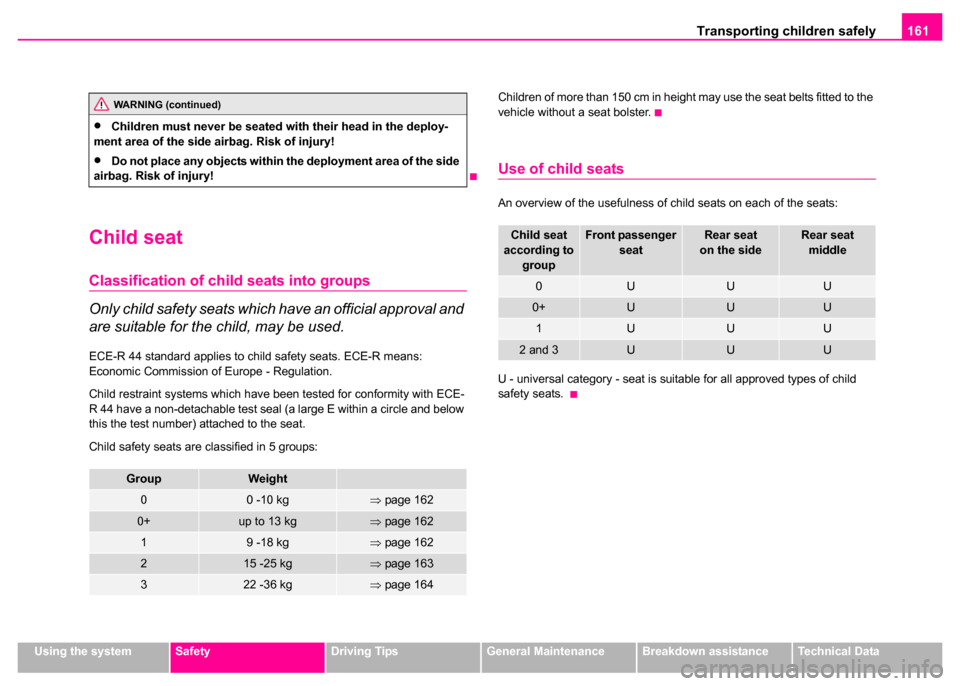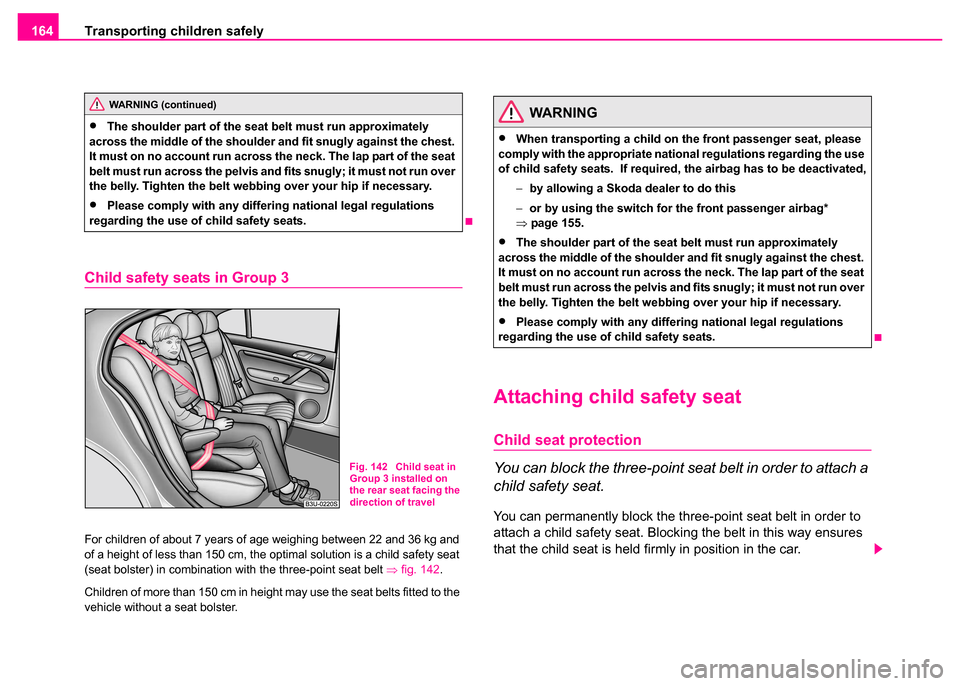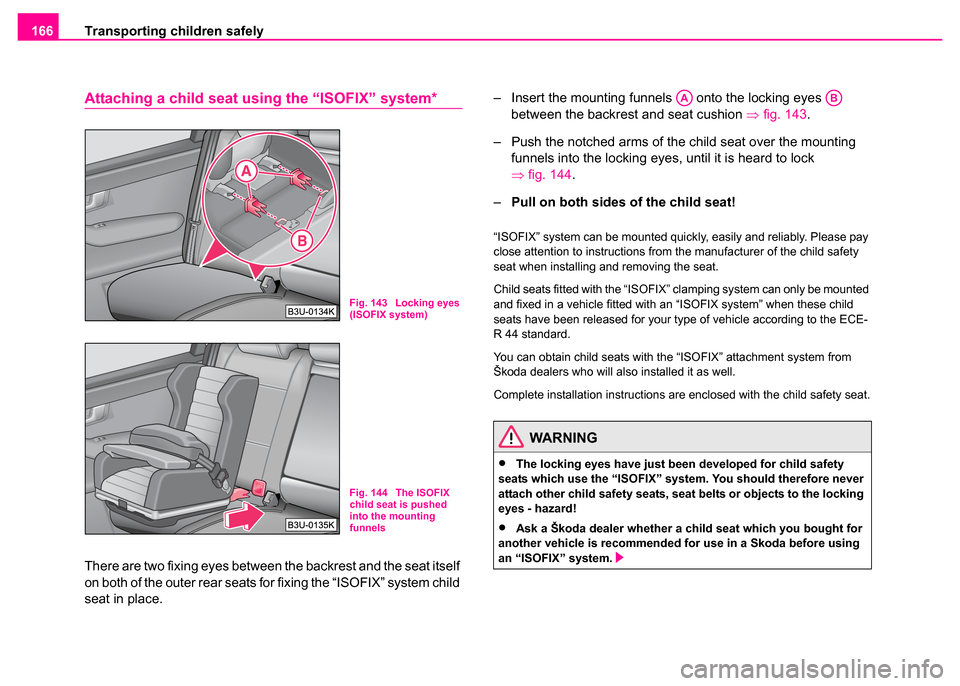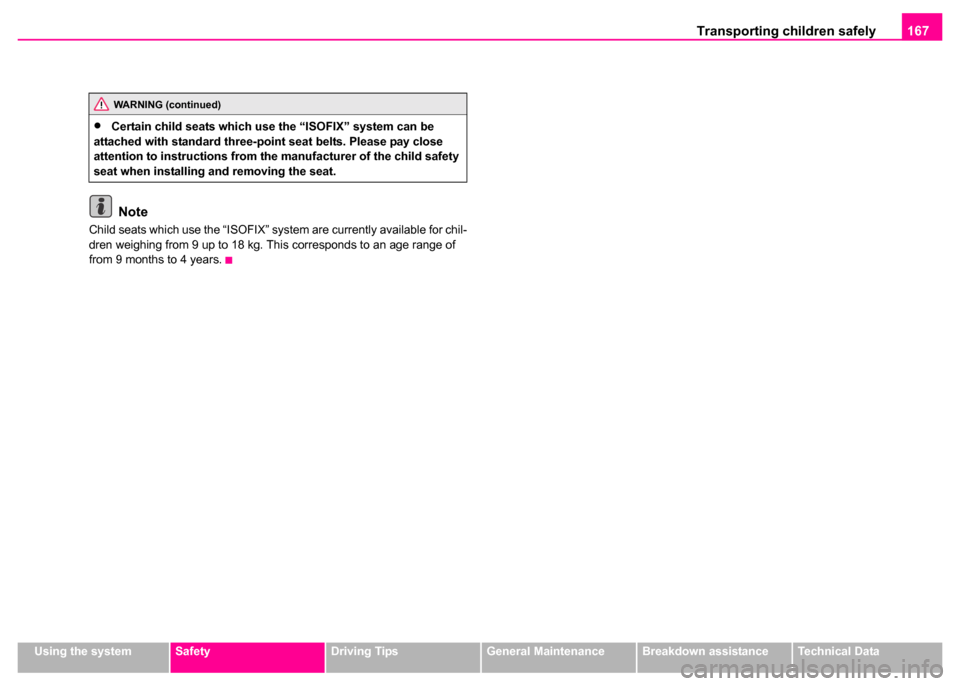SKODA SUPERB 2003 1.G / (B5/3U) Owner's Manual
Manufacturer: SKODA, Model Year: 2003, Model line: SUPERB, Model: SKODA SUPERB 2003 1.G / (B5/3U)Pages: 259
Page 161 of 259

Transporting children safely
160
Child safety and side airbags
Children must never be seated in the deployment area of
the side airbags and head airbags.In the event of a side collision, the side airbags offer the vehicle occupants
enhanced protection.
The side airbags are inflated in fractions of a second in order to be able to
provide this protection ⇒page 150, “Function of the side airbags”.
An airbag inflating develops such a strong force that an occupant who has
not adopted an upright seated position may suffer injuries from the airbag
or as a result of objects which are located within the deployment area of
the side airbag.
This applies particularly to children if they are not transported in
accordance with legal requirements.
Correct seated position of the child - a suitable child safety seat
protects the child.
The child is protected when seated in a child safety seat matching its age.
Adequate room is available between the child and the deployment area of
the side airbag and head airbag. The airbag offers optimal protection.
Fig. 137 Seated posi-
tion of an unprotected
child at risk from side
airbag
Fig. 138 Child properly
protected by safety
seat
WARNING
•It is essential to always switch off ⇒page 154 the front
passenger airbag when attaching a child safety seat on the front
passenger seat where the child is seated with its back facing in
direction of travel (in some countries also when the child is facing
the direction of travel). If this is not done, there is a risk of the child
suffering severe or even fatal injuries if the front passenger airbag
is deployed. In certain countries national legal provisions also
require that the side or head passenger airbags be deactivated.
When transporting a child on the front passenger seat, please
comply with the appropriate national regulations regarding the use
of child safety seats.
•When transporting a child on the front passenger seat, please
comply with the appropriate national regulations regarding the use
of child safety seats.
Page 162 of 259

Transporting children safely 161
Using the systemSafetyDriving TipsGeneral MaintenanceBreakdown assistanceTechnical Data
Child seat
Classification of child seats into groups
Only child safety seats which have an official approval and
are suitable for the child, may be used.
ECE-R 44 standard applies to child safety seats. ECE-R means:
Economic Commission of Europe - Regulation.
Child restraint systems which have been tested for conformity with ECE-
R 44 have a non-detachable test seal (a large E within a circle and below
this the test number) attached to the seat.
Child safety seats are classified in 5 groups: Children of more than 150 cm in height may use the seat belts fitted to the
vehicle without a seat bolster.
Use of child seats
An overview of the usefulness of child seats on each of the seats:
U - universal category - seat is suitable for all approved types of child
safety seats.
WARNING (continued)
•Children must never be seated with their head in the deploy-
ment area of the side airbag. Risk of injury!
•Do not place any objects within the deployment area of the side
airbag. Risk of injury!
GroupWeight
00 -10 kg⇒ page 162
0+up to 13 kg⇒page 162
19 -18 kg⇒page 162
215 -25 kg⇒page 163
322 -36 kg⇒page 164
Child seat
according to
groupFront passenger seatRear seat
on the sideRear seat middle
0UUU
0+UUU
1UUU
2 and 3UUU
Page 163 of 259

Transporting children safely
162
Child seats of group 0/0+
The optimal solution for babies of up to about 9 months old weighing up
to 10 kg or babies up to about 18 months old weighing up to 13 kg is a
child safety seat which can be adjusted into the reclining position
⇒ page 162, fig. 139 .
In view of the fact that such child seats are installed that the child is seated
with its back facing the direction of travel, they must not be used on the
front passenger seat ⇒page 158, “Use of child safety seats on the front
passenger seat”.Child safety seats in Group 1
WARNING
•It is essential to always switch off the front passenger airbag
(airbags) when attaching in exceptional circumstances a child
safety seat on the front passenger seat where the child is seated
with its back facing in direction of travel (in some countries also
when the child is facing the direction of travel).
−by allowing a Skoda dealer to do this
Fig. 139 Child seats of
group 0/0+
WARNING (continued)
− or by using the switch for the front passenger airbag*
⇒ page 155.
•The national legal provisions in certain countries require that
both the front, side and head airbags be deactivated. Please
comply with any differing nationa l legal regulations regarding the
use of child safety seats.
•If this is not done, a child seated on the front passenger seat
may suffer severe or even fatal injuries if the front passenger
airbag or airbags are deployed.
•You should have the front passenger airbag (or airbags) reacti-
vated by your Škoda dealer just as soon as you no longer use a
child safety seat on the front passenger seat.
Fig. 140 Child seat
with padded table in
Group 1 installed on
rear seat facing the
direction of travel
Page 164 of 259

Transporting children safely 163
Using the systemSafetyDriving TipsGeneral MaintenanceBreakdown assistanceTechnical Data
Child seats in Group 1 are for babies and small children up to 4 years of
age with a weight of between 9 and 18 kilograms. It is best for children in
the lower range of this group, to use a child seat which allows the child to
sit with its back to the direction of travel. It is best for children in the upper
range of the Group 0+, to use a child seat which allows the child to sit
⇒
fig. 140 in the direction of travel.
Child safety seats in which the child is seated with its back facing the
direction of travel, must not be used on the front passenger seat
⇒ page 158, “Use of child safety seats on the front passenger seat”.
Child safety seats in Group 2
For children up to about 7 years of age weighing between 15 and 25 kg
the optimal solution is a child safety seat in combination with the three-
point seat belt ⇒fig. 141 .
WARNING
•It is essential to always switch off the front passenger airbag
(airbags) when attaching in exceptional circumstances a child
safety seat on the front passenger seat where the child is seated
with its back facing in direction of travel (in some countries also
when the child is facing the direction of travel).
−by allowing a Skoda dealer to do this
− or by using the switch for the front passenger airbag*
⇒ page 155.
•The national legal provisions in certain countries require that
both the front, side and head airbags be deactivated. Please
comply with any differing national legal regulations regarding the
use of child safety seats.
•If this is not done, a child seated on the front passenger seat
may suffer severe or even fatal injuries if the front passenger
airbag or airbags are deployed.
•You should have the front passenger airbag (or airbags) reacti-
vated by your Škoda dealer just as soon as you no longer use a
child safety seat on the front passenger seat.
WARNING
•When transporting a child on the front passenger seat, please
comply with the appropriate national regulations regarding the use
of child safety seats. If required, the airbag has to be deactivated,
−by allowing a Skoda dealer to do this
− or by using the switch for the front passenger airbag*
⇒ page 155.
Fig. 141 Child seat in
Group 2 installed on
the rear seat facing the
direction of travel
Page 165 of 259

Transporting children safely
164
Child safety seats in Group 3
For children of about 7 years of age weighing between 22 and 36 kg and
of a height of less than 150 cm, the optimal solution is a child safety seat
(seat bolster) in combination with the three-point seat belt ⇒fig. 142 .
Children of more than 150 cm in height may use the seat belts fitted to the
vehicle without a seat bolster.
Attaching child safety seat
Child seat protection
You can block the three-point seat belt in order to attach a
child safety seat.
You can permanently block the three-point seat belt in order to
attach a child safety seat. Blocking the belt in this way ensures
that the child seat is held firmly in position in the car.
WARNING (continued)
•The shoulder part of the seat belt must run approximately
across the middle of the shoulder and fit snugly against the chest.
It must on no account run across the neck. The lap part of the seat
belt must run across the pelvis and fits snugly; it must not run over
the belly. Tighten the belt webbing over your hip if necessary.
•Please comply with any differi ng national legal regulations
regarding the use of child safety seats.
Fig. 142 Child seat in
Group 3 installed on
the rear seat facing the
direction of travel
WARNING
•When transporting a child on the front passenger seat, please
comply with the appropriate national regulations regarding the use
of child safety seats. If required, the airbag has to be deactivated,
−by allowing a Skoda dealer to do this
− or by using the switch for the front passenger airbag*
⇒ page 155.
•The shoulder part of the seat belt must run approximately
across the middle of the shoulder and fit snugly against the chest.
It must on no account run across the neck. The lap part of the seat
belt must run across the pelvis and fits snugly; it must not run over
the belly. Tighten the belt webbing over your hip if necessary.
•Please comply with any differ ing national legal regulations
regarding the use of child safety seats.
Page 166 of 259

Transporting children safely 165
Using the systemSafetyDriving TipsGeneral MaintenanceBreakdown assistanceTechnical Data
Activating child seat protection
– Attach the child safety seat with the three-point seat belt as
stated in the instructions of the manufacturer of the child seat.
– Now, pull the shoulder part of the belt out fully.
– Insert the tongue of the lock into the seat belt buckle belonging to the seat until it is heard to lock in place.
– Reel up the belt webbing until it is fitted snugly against the child seat. When the belt is reeled up, this can be detected by
a “clicking” noise.
– Pull on the belt in order to check that it is no longer possible to pull out the webbing. The child seat protection is now switched
on.
Deactivating child seat protection
– Press the red button on the seat belt buckle. The tongue of the lock jumps out of the buckle as a result of the spring force
when this is done.
– Guide the belt back with your hand to enable the inertia reel to wind up the belt webbing more easily. The child safety lock is
deactivated after the full reeling up of the belt.WARNING
It is essential to always switch off ⇒page 154 the airbag (airbags)
when attaching a child safety seat on the front passenger seat
where the child is seated with its back facing in direction of travel
(in some countries also when the child is facing the direction of
travel). If this is not done, there is a risk of the child suffering
severe or even fatal injuries if the front passenger airbag is
deployed. In certain countries national legal provisions also
require that the side or head passenger airbags be deactivated.
When transporting a child on the front passenger seat, please
comply with the appropriate national regulations regarding the use
of child safety seats.
Page 167 of 259

Transporting children safely
166
Attaching a child seat using the “ISOFIX” system*
There are two fixing eyes between the backrest and the seat itself
on both of the outer rear seats for fixing the “ISOFIX” system child
seat in place. – Insert the mounting funnels onto the locking eyes
between the backrest and seat cushion ⇒fig. 143 .
– Push the notched arms of the child seat over the mounting funnels into the locking eyes, until it is heard to lock
⇒fig. 144 .
– Pull on both sides of the child seat!
“ISOFIX” system can be mounted quickly, easily and reliably. Please pay
close attention to instructions from the manufacturer of the child safety
seat when installing and removing the seat.
Child seats fitted with the “ISOFIX” clamping system can only be mounted
and fixed in a vehicle fitted with an “ISOFIX system” when these child
seats have been released for your type of vehicle according to the ECE-
R 44 standard.
You can obtain child seats with the “ISOFIX” attachment system from
Škoda dealers who will also installed it as well.
Complete installation instructions are enclosed with the child safety seat.
Fig. 143 Locking eyes
(ISOFIX system)
Fig. 144 The ISOFIX
child seat is pushed
into the mounting
funnels
WARNING
•The locking eyes have just been developed for child safety
seats which use the “ISOFIX” system. You should therefore never
attach other child safety seats, seat belts or objects to the locking
eyes - hazard!
•Ask a Škoda dealer whether a child seat which you bought for
another vehicle is recommended for use in a Skoda before using
an “ISOFIX” system.
AAAB
Page 168 of 259

Transporting children safely 167
Using the systemSafetyDriving TipsGeneral MaintenanceBreakdown assistanceTechnical Data
Note
Child seats which use the “ISOFIX” system are currently available for chil-
dren weighing from 9 up to 18 kg. This corresponds to an age range of
from 9 months to 4 years.
WARNING (continued)
•Certain child seats which use the “ISOFIX” system can be
attached with standard three-point seat belts. Please pay close
attention to instructions from the manufacturer of the child safety
seat when installing and removing the seat.
Page 169 of 259

Transporting children safely
168
Page 170 of 259

Intelligent Technology169
Using the systemSafetyDriving TipsGeneral MaintenanceBreakdown assistanceTechnical Data
Driving Tips
Intelligent Technology
Electronic stability programme (ESP)*
General
General
The ESP aids you maintain control of your vehicle in situations in border-
line driving situations such as when negotiating a curve too fast. The risk
of skidding is reduced and your car thus offers greater driving stability
depending on the conditions of the road surface. This occurs at all speeds.
The following systems are integrated into the electronic stability
programme:
•Electronic Differential Lock (EDL)
•Traction control system (TCS)
•Antilock brake system ABS
•Brake Assist
Operating principle
The ESP switches on automatically when the engine is started and then
conducts a self-test. The ESP control unit processes data from the indi-
vidual systems. It also processes additional measurement data which are
supplied by highly sensitive sensors: the rotational velocity of the vehicle
about its vertical axis, the lateral acceleration of the vehicle, the braking
pressure and the steering angle.
The direction which the driver wishes to take is determined based on the
steering angle and the speed of the vehicle and is constantly compared
with the actual behaviour of the vehicle. If differences exist, such as the
car beginning to skid, the ESP will automatically brake the appropriate
wheel and reduce the engine speed.
The car is stabilised again by the forces which take effect when the wheel
is braked. Intervention into the brake system takes place primarily on the
outer front wheel of a vehicle which tends to oversteer (tendency for the
rear of the vehicle to break away) while occurs this is on the inner rear
wheel of a vehicle which tends to understeer (tendency to shift out of the
curve). This braking control cycle is accompanied by noises.
The ESP operates in combination with the ABS ⇒page 173. If there is a
fault in the ABS system, the ESP also does not operate.
Fig. 145 ESP switch